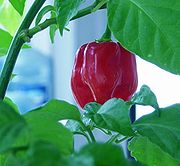Scoville scale
From Wikipedia, the free encyclopedia

The Scoville scale is a measure of the hotness or piquancy of a chili pepper, as defined by the amount of capsaicin (a chemical compound which stimulates nerve endings in the skin) present.
Some hot sauces use their Scoville rating in advertising as a selling point.
The scale is named after its creator, American chemist Wilbur Scoville, who developed a test for rating the pungency of chili peppers. His method, which he devised in 1912,[1] is known as the Scoville Organoleptic Test. An alternative method for quantitative analysis uses high-performance liquid chromatography, making it possible to directly measure capsaicinoid content.
Contents |
[edit] Details
Chili peppers, fruits of the Capsicum genus, contain capsaicin, a chemical compound which stimulates chemoreceptor nerve endings in the skin, especially the mucous membranes. The number of Scoville heat units (SHU) indicates the amount of capsaicin present.
[edit] Scoville Organoleptic Test
In Scoville's method, a solution of the pepper extract is diluted in sugar syrup until the "heat" is no longer detectable to a panel of (usually five) tasters; the degree of dilution gives its measure on the Scoville scale. Thus a sweet pepper or a bell pepper, containing no capsaicin at all, has a Scoville rating of zero, meaning no heat detectable, even undiluted. Conversely, the hottest chilis, such as habaneros, have a rating of 200,000 or more, indicating that their extract has to be diluted 200,000-fold before the capsaicin presence is undetectable. The greatest weakness of the Scoville Organoleptic Test is its imprecision, because it relies on human subjectivity.
[edit] High-performance liquid chromatography

Spice heat is now usually measured by a method using high performance liquid chromatography (HPLC). This identifies and measures the concentration of heat-producing chemicals. They are then used in a mathematical formula in which they are weighted according to their relative capacity to produce a sensation of heat. This method yields results, not in Scoville units, but in American Spice Trade Association (ASTA) pungency units. A measurement of one part capsaicin per million corresponds to about 15 Scoville units, and the published method says that ASTA pungency units can be multiplied by 15 and reported as Scoville units. This conversion is approximate, and spice experts Donna R. Tainter and Anthony T. Grenis say that there is consensus that it gives results about 20–40% lower than the actual Scoville method would have given.[2]
[edit] List of Scoville ratings
Pungency values for any pepper, stated in Scoville units, are imprecise, due to expected variation within a species—easily by a factor of 10 or more—depending on seed lineage, climate (humidity is a big factor for the Naga as the Dorset Naga and the original Naga have quite different ratings), and even soil (this is especially true of habaneros). The inaccuracies described in the measurement methods above also contribute to the imprecision of these values. When interpreting Scoville ratings, this should be kept in mind.[2]
| Scoville rating | Type of pepper |
|---|---|
| 15,000,000–16,000,000 | Pure capsaicin[3] |
| 8,600,000–9,100,000 | Various capsaicinoids (e.g. homocapsaicin, homodihydrocapsaicin, nordihydrocapsaicin) |
| 500,000–5,300,000 | Law Enforcement Grade pepper spray,[4] FN 303 irritant ammunition |
| 855,000–1,050,000 | Naga Jolokia[5][6] |
| 350,000–580,000 | Red Savina Habanero[7][8] |
| 100,000–350,000 | Habanero chili,[9] Scotch Bonnet Pepper,[9] Datil pepper, Rocoto, Jamaican Hot Pepper, African Birdseye, Madame Jeanette |
| 50,000–100,000 | Thai Pepper,[10] Malagueta Pepper,[10] Chiltepin Pepper, Pequin Pepper[10] |
| 30,000–50,000 | Cayenne Pepper, Ají pepper,[9] Tabasco pepper, some Chipotle peppers |
| 10,000–23,000 | Serrano Pepper, some Chipotle peppers |
| 2,500–8,000 | Jalapeño Pepper, Guajillo pepper, New Mexican varieties of Anaheim pepper,[11] Paprika (hungarian wax pepper) |
| 500–2,500 | Anaheim pepper, Poblano Pepper, Rocotillo Pepper |
| 100–500 | Pimento, Pepperoncini, Bell pepper |
| 0 | No heat |
[edit] References
- ^ The Journal of the American Pharmacists Association 1912; 1:453–4
- ^ a b Tainter, Donna R.; Anthony T. Grenis (2001). Spices and Seasonings. Wiley-IEEE. pp. 30. ISBN 0-471-35575-5. http://books.google.com/books?ie=UTF-8&visbn=0471355755&id=dfp4b3F0598C&pg=PA30&lpg=PA30&dq=scoville+units&sig=Kf0jDoOAoRK1rVKTgFT71bk-DHE. — "Interlab variation [for the original Scoville scale] could be as high as + / - 50%. However, labs that run these procedures could generate reasonably repeatable results."
- ^ Uhl (1996), op. cit. "The HPLC measures the capsaicinoid(s) in ppm, which can then be converted to Scoville units using a conversion factor of 15, 20 or 30 depending on the capsaicinoid." This would make capsaicin 15,000,000
- ^ "The Police Policy Studies Council". www.theppsc.org. http://www.theppsc.org/Staff_Views/Czarnecki/chemical_hazards_in_law_enforcement.htm. Retrieved on 2009-02-09. "Most law enforcement sprays have a pungency of 500,000 to 2 million SHU. One brand has sprays with 5.3 million SHU."
- ^ Shaline L. Lopez (2007). "NMSU is home to the world's hottest chile pepper" (html). http://www.nmsu.edu/~ucomm/Releases/2007/february/hottest_chile.htm. Retrieved on 2007-02-21.
- ^ AP (23 February 2007). "World's hottest chili pepper a mouthful for prof". CNN. Archived from the original on 2007-03-22. http://web.archive.org/web/20070322224224/http://www.cnn.com/2007/US/02/23/hot.pepper.ap/index.html.
- ^ "What is a Habanero Pepper?". wisegeek.com. http://www.wisegeek.com/what-is-a-habanero-pepper.htm. Retrieved on 2008-03-31.
- ^ "World's hottest chile pepper discovered". American Society for Horticultural Science. http://www.bio-medicine.org/biology-news-1/Worlds-hottest-chile-pepper-discovered-991-1/. Retrieved on 2008-03-31.
- ^ a b c "Chile Pepper Heat Scoville Scale". About.com. http://homecooking.about.com/library/weekly/blhotchiles.htm. Retrieved on 2006-09-25.
- ^ a b c "Scoville Scale Chart for Hot Sauce and Hot Peppers". ScottRobertsWeb.com. http://www.scottrobertsweb.com/scoville-scale.php. Retrieved on 2008-11-19.
- ^ "Anaheim Pepper" (PDF). Chile Pepper Institute at New Mexico State University. 2007. http://www.chilepepperinstitute.org/documents/chileheat.pdf. Retrieved on 2007-10-22.
|
|||||||||||||||||


